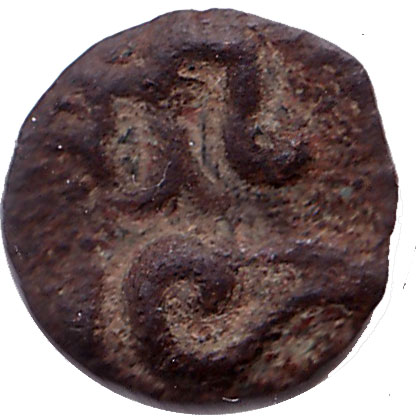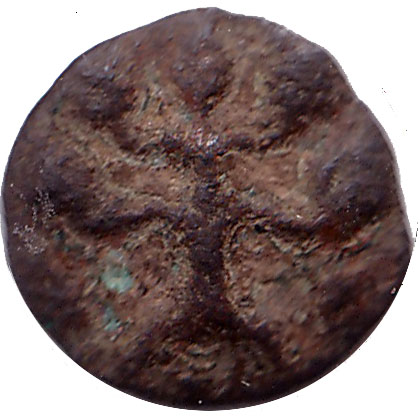| SPECIFICATIONS | |
| Alloy | Copper |
| Type | Struck |
| Diameter | 8.9 mm |
| Thickness | 0.5 mm |
| Weight | 0.26 gms |
| Shape | Round |
| Edge | Rough |
| Die Axis | 180° |


|

| 
| ||||||||||||||||||
Former President of the Sri Lanka Numismatic Society K. N. V. Seyone argued in 1990 that by adding together the symbols on Obverse and Reverse, we can infer the coin could have issued by a king whose name was Shri Sangha Bodhi. See discussion by Brig. Siri Munasingha
The Mahavamsa mentions Siri Sangha Bodhi I(306-308 CE), who was King in Anuradhapura was committed to the Buddha's teachings(dharma-vira) that he refused to execute criminals. When his Treasurer, Minister Gotabaya rebeled against him, he could not bear the thought of the bloodshed that would result from putting down the rebellion, so he voluntarily abdicated and retired to the forest to live as an ascetic. The minister, now King Gathabhaya, fearing the return of the rightful king, offered a reward to anyone who would bring him the head of Siri Sanghabodh. One day, a poor peasant shared his meal with Siri Sanghabodh who, having nothing to give him in return, informed the man of his identity and offered him his head, decapitating himself.
Nagari lettering was not used on coins during the era of this famous SiriSangabodhi. However Sinhala rulers from the 7th up to the 12th Century CE alternately adopted his name as the throne name, as a symbol of the Hero of Righteousness. There after all the ruler called them self Siri Samga Bodhi up to 16th Century, this is evident on all their inscriptions.
Seyone tentetively identifies the coin King Aggabodhi III(633-644 CE)
The coin was scanned at 1200 dpi and displayed at 600 dpi. It was from the collection of Brigadier Siri Munasinghe